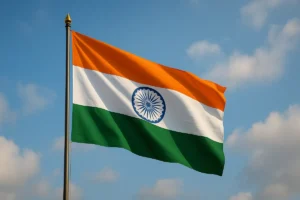National Flag of India Facts

National Flag of India - Facts
- The Indian National Flag is a horizontal tricolour of saffron at the top, white in the middle, and green at the bottom. In the centre of the white band is a navy blue wheel with twenty-four spokes, known as the Ashoka Chakra, which is derived from the Ashoka Pillar at Sarnath.
- In India, the flag is commonly referred to as the “Tricolour” (Tiranga).
- Each colour has its own symbolism: Saffron represents courage and sacrifice. White stands for honesty, peace, and purity and Green denotes faith, fertility, prosperity, and chivalry.
- The ratio of the national flag of India has height to the width of the flag is 2:3.
- The diameter of the Ashoka Chakra is three-fourths of the height of the white band.
- By law, the National Flag must be made of Khadi, a hand-spun and handwoven cloth.
- The Karnataka Khadi Gramodyoga Samyukta Sangha (KKGSS) is the only licensed manufacturer and supplier of the Indian National Flag.
Historical Highlights:
- The first unofficial Indian flag was hoisted on 7th August 1906 at Parsee Bagan Square (Green Park), Kolkata by Schindra Prasad Bose. It featured three horizontal bands of red, yellow, and green.
- On 22nd August 1907, Madam Bhikaiji Cama unfurled a tricolour in Stuttgart, Germany. It had green at the top, saffron in the middle, and red at the bottom—the first Indian flag displayed on foreign soil.
- In 1916, Pingali Venkayya, a freedom fighter from Andhra Pradesh, proposed over 30 designs for the national flag in his book. His final design was approved by Mahatma Gandhi during a Congress session in Vijayawada in 1921.
- In 1931, the Congress Party adopted a flag with saffron, white, and green, featuring the Charkha (spinning wheel) in the centre. It was a precursor to the current national flag.
- The present National Flag of India was officially adopted by the Constituent Assembly on 22nd July 1947.
Flag Usage and Milestones:
- Before 26th January 2002, the general public in India was not allowed to hoist the national flag of India except on national holidays. The Flag Code of India was amended to allow citizens to fly the flag on any day, provided dignity, honour, and respect are maintained.
- The design and specifications for the national flag are governed by three documents issued by the Bureau of Indian Standards (BIS).
- On 29th May 1953, Tenzing Norgay hoisted the Indian flag atop Mount Everest, the highest peak in the world.
- In 1984, when Wing Commander Rakesh Sharma became the first Indian in space, the national flag flew with him as a medallion on his spacesuit.
- The world’s largest Khadi Indian flag was unveiled in Leh, Ladakh, on 2nd October 2021, commemorating the 152nd birth anniversary of Mahatma Gandhi.
- When a foreign dignitary travels in a car provided by the Indian government, the Indian flag is flown on the right side, and the foreign nation’s flag is flown on the left.
The National Flag of India is not just a symbol of independence but also a reflection of the country’s unity, culture, and values. Understanding its history and meaning helps us appreciate the sacrifices made for freedom and the pride it brings to every citizen.
For more insights on India’s rich heritage, explore our detailed section on Important State wise Symbols of India. To learn about official guidelines and protocols related to the flag, you can also visit the Ministry of Home Affairs – Flag Code of India.
